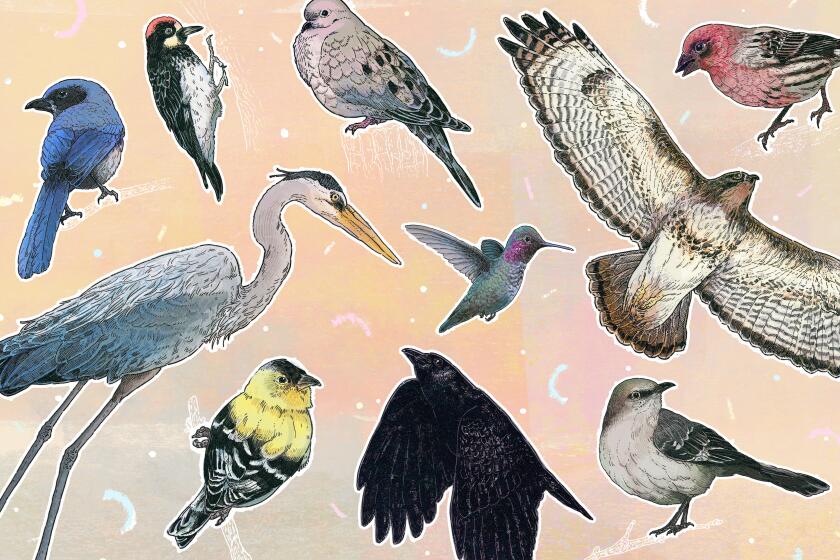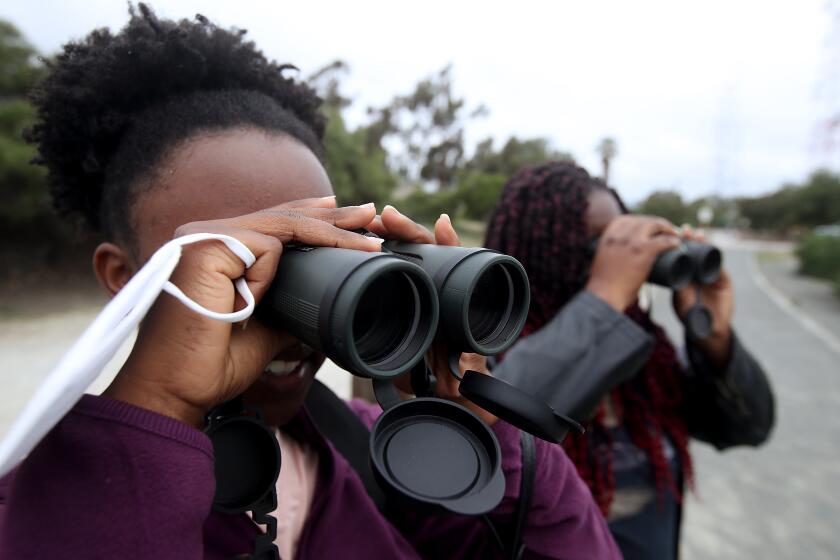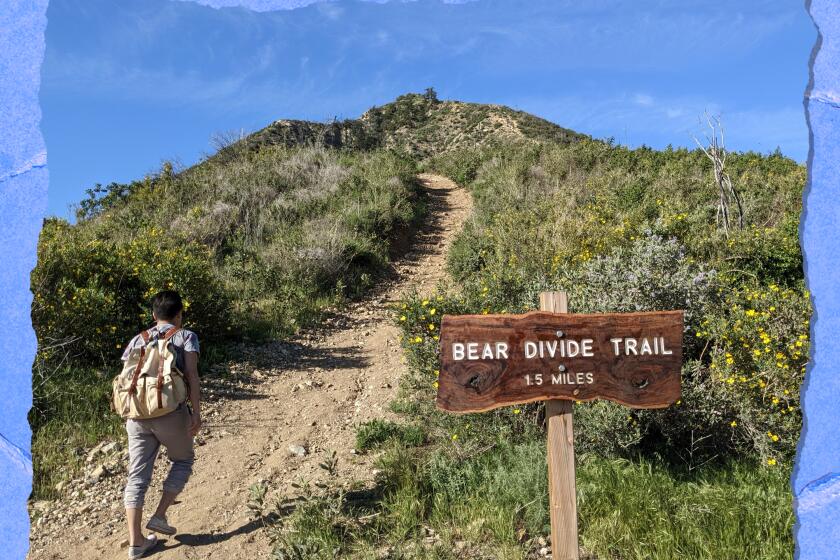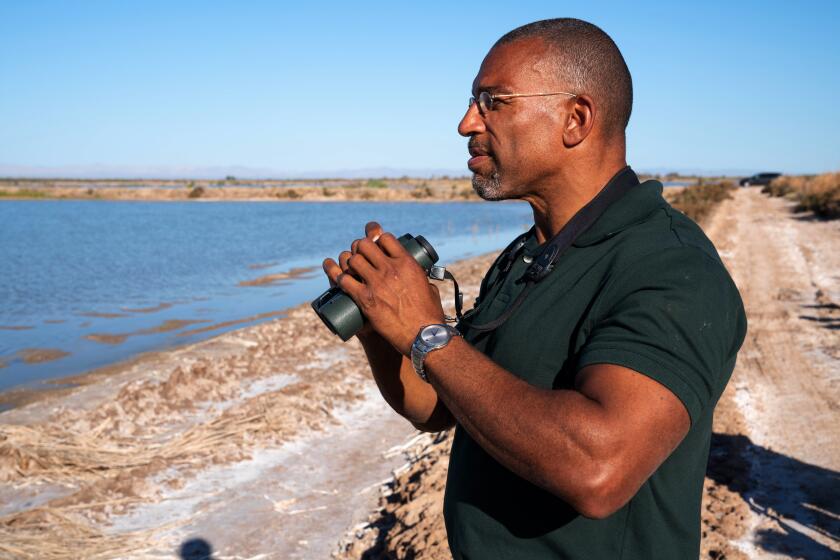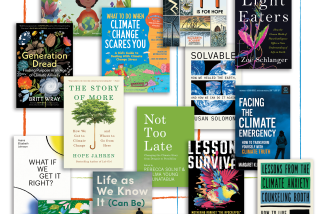4 must-read books on birding (and 2 bonus picks)
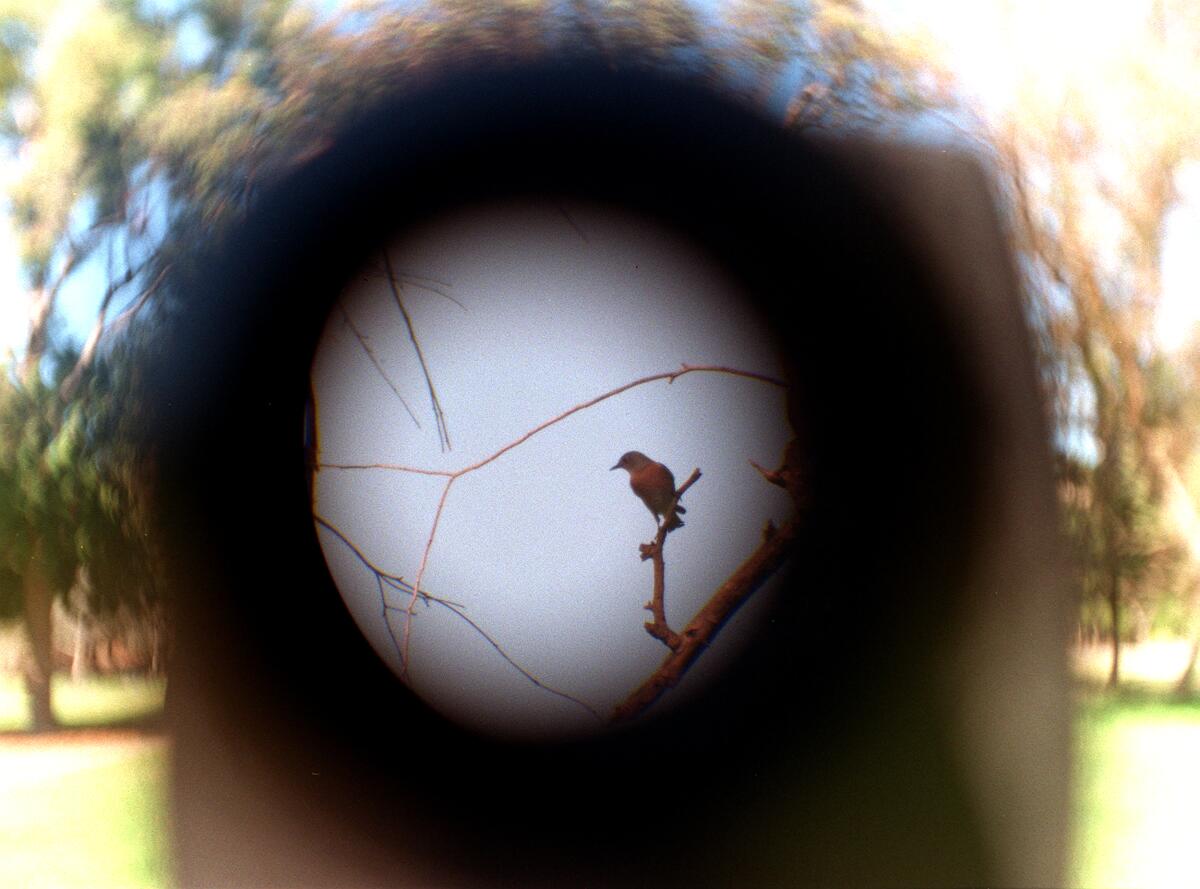
If you buy books linked on our site, The Times may earn a commission from Bookshop.org, whose fees support independent bookstores.
In times of stress or boredom, people look for distractions. During the worrisome months of the pandemic lockdown in 2020 and through the anxious months before the first vaccines became available, so many people took up breadmaking that King Arthur flour became a hot commodity.
They also took up bird-watching — a safe way to be outdoors, perfect for the restless, the contemplative, the curious and, for those keeping life lists, the competitive and compulsive.
In cities, people flocked to parks with binoculars — or opera glasses. Wildlife preserves were filled with hikers seeking fresh air with a side of hermit thrush. Others stayed put and gained a new appreciation for the winged creatures in their own backyards.
Four years later, there’s a spate of new books about birding capitalizing on this heightened interest. (It’s not quite as profuse as the plethora of pandemic novels, but it’s a significant uptick.) Their authors range from longtime birders to more recent devotees. What they have in common is that they all highlight the comfort and joy to be found in paying closer attention to our avian friends.
It’s easy to start birding in your backyard. All you need are binoculars and a bit of curiosity
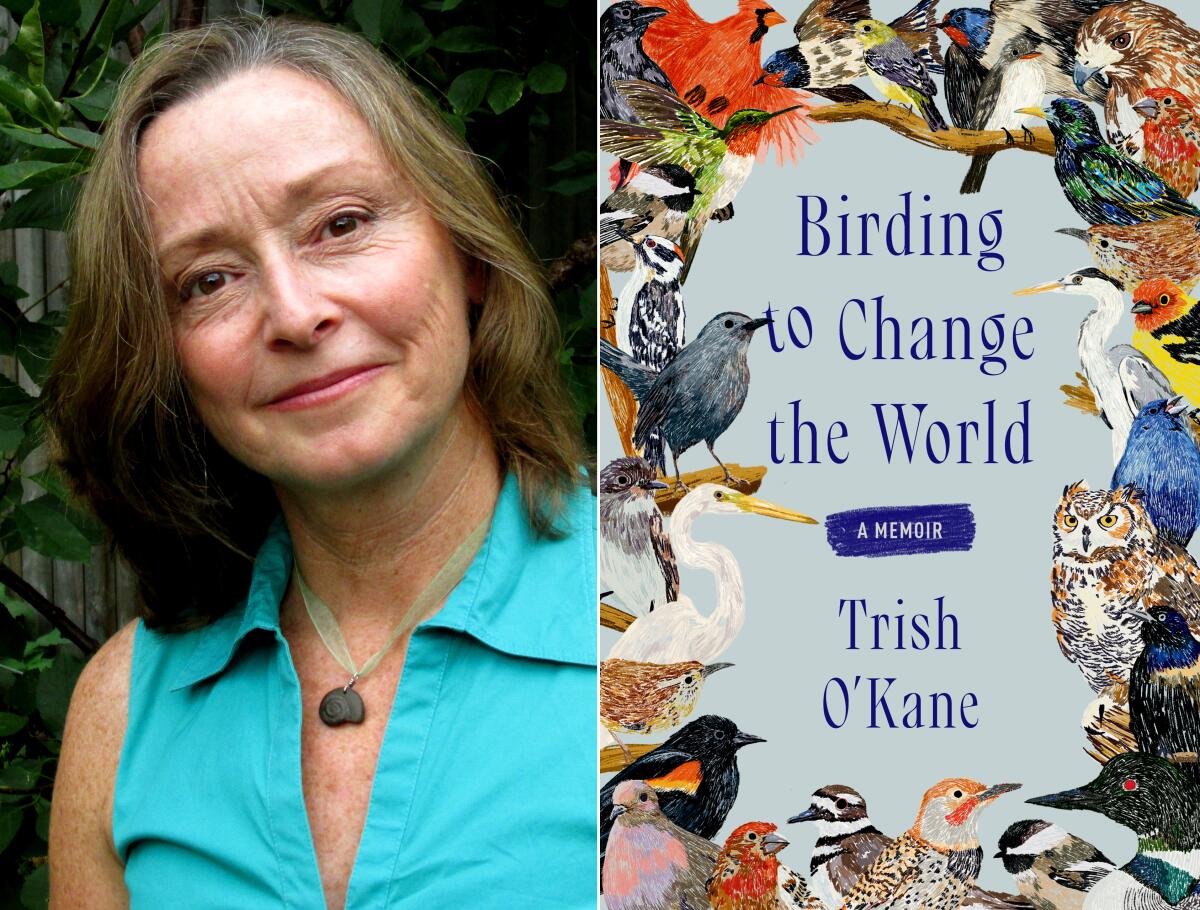
Birding to Change the World
By Trish O’Kane
Ecco: 368 pages, $30
Trish O’Kane’s heartening memoir, “Birding to Change the World,” chronicles the balm she found in birds following the devastating loss of her New Orleans home during Hurricane Katrina — and how this led to her new life as an environmental activist promoting wildland conservation.
“For every birdwatcher there is a portal bird, one that opens your eyes to a world governed by curiosity, daily surprises and sudden intimate glimpses into feathered lives,” O’Kane writes. For her, it was the common house sparrow, which she would observe before heading to her job teaching journalism at Loyola University New Orleans when it reopened in January 2006, five months after Katrina. She realized that bird-watching was “like journalism. ... You observe. You listen. You take good notes. You piece together clues.”
But, shaken by the devastation she saw in New Orleans, O’Kane, in her mid-40s, decided to return to school for a PhD in environmental studies at the University of Wisconsin-Madison. Enchanted by catbirds singing near her new home, she signed up for an ornithology class and became a regular at Warner Park, a recreation center and urban wildlife refuge.
O’Kane was hooked. But with her passion came concerns for the future of this nature preserve in the face of further development. She became a vocal presence at town council meetings. Madison’s annual Fourth of July fireworks extravaganza raised multiple alarms, as the detonations traumatized roosting birds and sent them fleeing, many into traffic, and damaged wetland duck habitats with toxic detritus.
Another concern: O’Kane noticed that local lower-income children had little access to the wonders of nature. She created an afterschool birding club in which college students mentored middle school children — a program she has continued at the University of Vermont, with student mentors recruited from her “Birding to Change the World” class.
O’Kane’s work — and this book — are primers in the arts of observation and environmental activism.
Black birders have found community in Los Angeles because of online movements to change America’s perception of who spends leisure time outdoors.
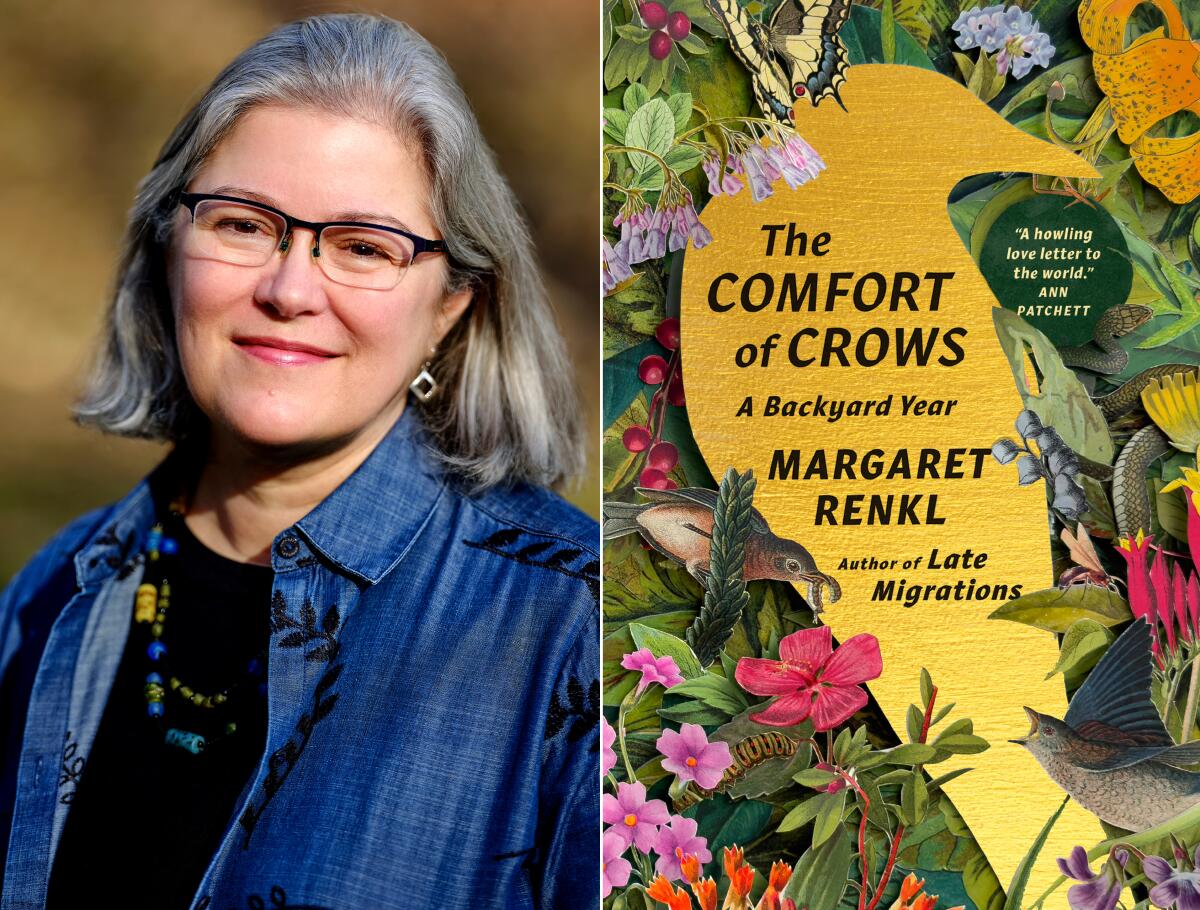
The Comfort of Crows: A Backyard Year
By Margaret Renkl
Spiegel & Grau: 288 pages, $32
In two books about backyard birding, novelist Amy Tan and New York Times contributing opinion writer Margaret Renkl make a case for the pleasure to be had from closely observing birds without leaving one’s own nest.
Renkl’s “The Comfort of Crows” is a full-throated appreciation of the critters who populate her half-acre yard in Nashville. In 52 weekly entries, she sings the praises of clever crows and is heartened by the sight of blue jays and mockingbirds enjoying the heated birdbath she installed for them. Watching with delight in spring as a male redbird presents his mate with an edible demonstration of his “fitness as a partner,” she comments, “In the avian world, a grub is an engagement ring.”
But Renkl, like O’Kane, has her worries. Should she intervene when a bird is in distress? (She often calls wildlife experts for advice.) She is heartsick about the state of our planet and mourns the razing of a former neighbor’s house, along with the giant shade tree beside it. She also rues the ubiquity of leaf blowers and poisons in Americans’ pursuit of tidy, manicured lawns, which provide no shelter for overwintering creatures.
What neighbors view as an unkempt weed patch in her backyard, she considers a “pocket of biodiversity” — food for birds and safe havens for bees — and a source of restorative hope.
Beautifully illustrated by her brother, Billy Renkl, “The Comfort of Crows” may help readers see their own microcosms in a different light.
Ardent birders are flocking to this remote forest location to find myriad migrating species.
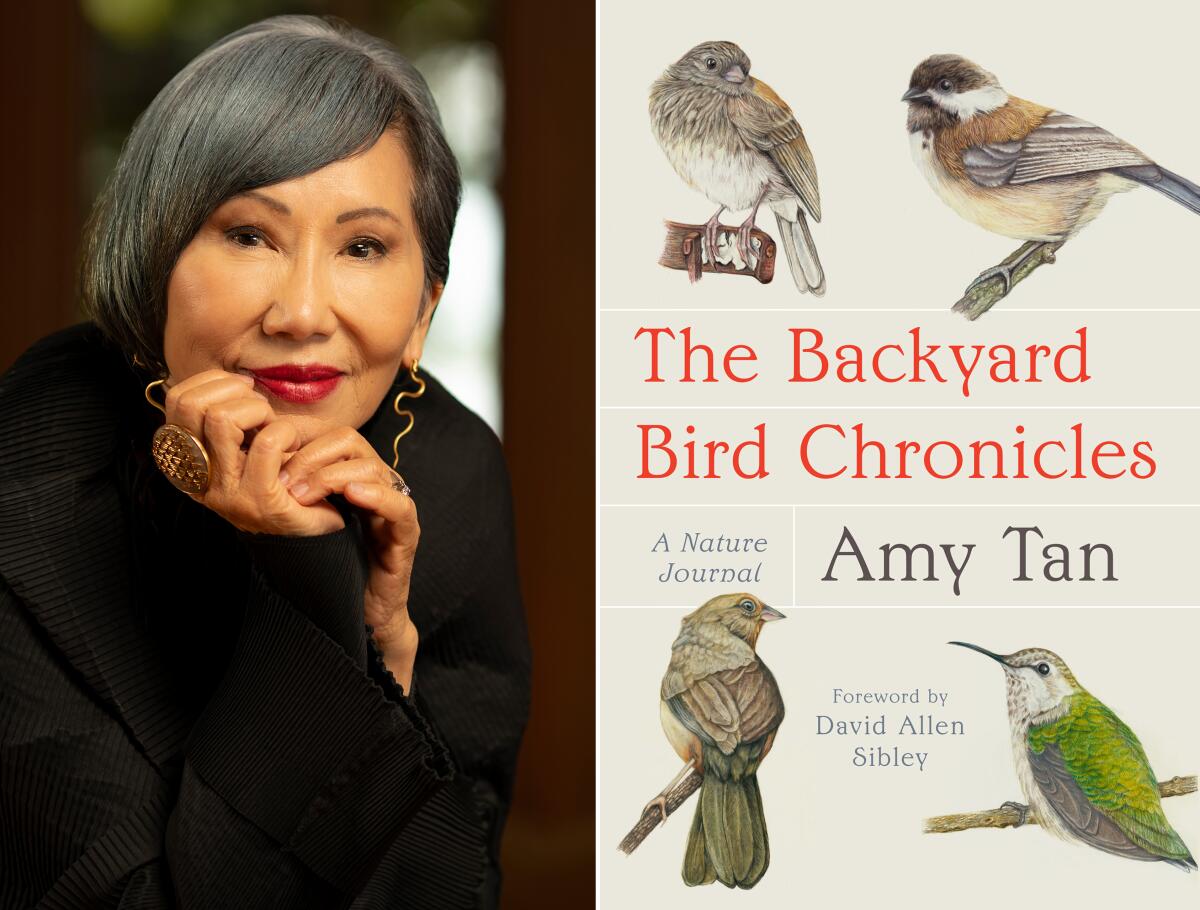
The Backyard Bird Chronicles
Written and illustrated by Amy Tan
Knopf: 320 pages, $35
In “The Backyard Bird Chronicles,” out April 23, Amy Tan shares the delightful results of her confessed obsession with the birds that frequent her Sausalito yard. The book is a chronological selection from hundreds of pages of nature journals she wrote and illustrated between 2017 and 2022.
Tan’s lovely graphite and colored pencil drawings reveal yet another side of the multitalented author of “The Joy Luck Club” and lead singer in the Rock Bottom Remainders, a band of writers. She took her first drawing classes in 2016, at 64, and you can see her skills develop over the course of this charming volume.
Tan’s gorgeous aerie above San Francisco Bay, with its canopy of four Pacific live oaks, is a paradise for birds, hosting 63 species and counting. Her depictions of their habits and foibles are laced with considerable wit — and subjective assessments: “rascally” California scrub jays, “voracious” Townsend’s warblers, “solitary nonconformist” hermit thrushes, murderous crows, fiercely competitive hummingbirds.
Tan’s yard has been kitted out with a variety of bird feeders (including rat-deterrent feeding cages), hot pepper suet (which squirrels abhor) and saucers of fresh water “to lure these birds to check out my woodland habitat and make it so irresistible they would never leave.” Tan says she spends about $250 a month on live mealworms for “Amy’s Bistro,” which she rationalizes “by calculating the amount of money I have saved by not having children.” That, and her hard work outsmarting squirrels and rats, help ensure that Tan’s fine feathered friends will perch close enough for her to observe their beaks, toe grasps, coloration, food preferences and pecking orders — and capture it all on paper.
Writing “The Backyard Bird Chronicles,” Tan says, involves the same propensity for observation that drives her fiction. But unlike shaping a novel, this book has been “pure fun.” “Thanks to the birds, I have never felt cooped up staying at home. So much remains new, so much can be discovered,” she writes. Her bird chronicles are fun, too — and informative.
Christian Cooper, author of “Better Living Through Birding” and host of Disney+’s “Extraordinary Birder,” joins the L.A. Times Book Club Aug. 16.
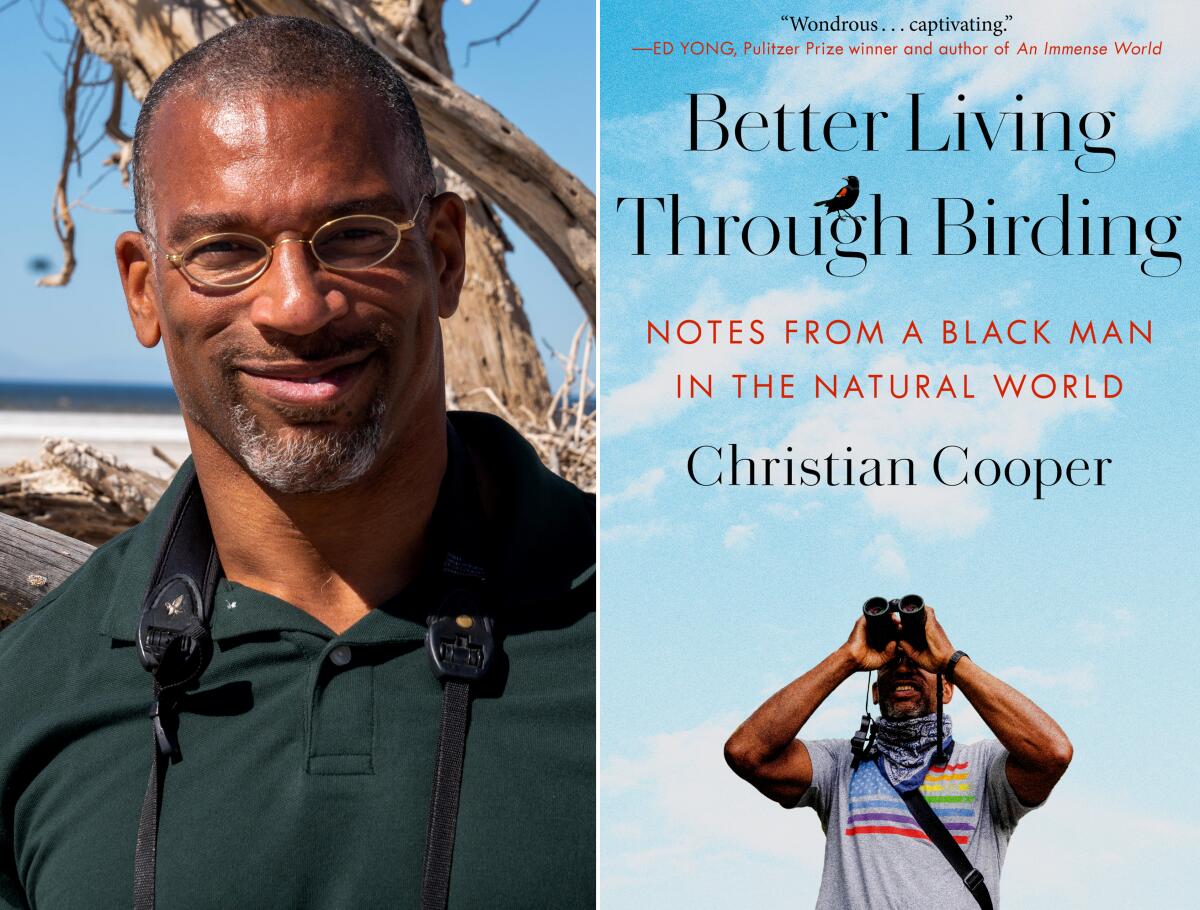
Better Living Through Birding: Notes From a Black Man in the Natural World
By Christian Cooper
Random House: 304 pages, $28
Christian Cooper is an avid lifelong birder, comics fan, writer and self-described gay Blerd — Black nerd — whose racially charged run-in with a dog-walker in Manhattan’s Central Park in May 2020 catapulted him to fame. He tells his life story in “Better Living Through Birding: Notes From a Black Man in the Natural World.”
There’s nothing casual about Cooper’s birding: he is the kind of binocular-toting obsessive who heads to Central Park before work every spring morning to catch specific migratory species en route from their southern wintering grounds to their summer habitats up north. So when he sees an unleashed dog running roughshod through the Ramble on the day he’s on the hunt for a ground-dwelling mourning warbler, he reminds the owner of the leash law. When the owner refuses to comply, he videotapes her. The situation quickly escalates, and Amy Cooper (no relation) calls 911 to report that an African American man is threatening her life. His Facebook post about the exchange goes viral, to the tune of 45 million views within a few hours. After careful consideration, “constrained by a sense of proportionality,” Cooper chose not to press charges. But his new fame changed his life — leading to this book and a job hosting “Extraordinary Birder” on National Geographic, among other things.
There’s much more in “Better Living Through Birding” than “the incident.” Cooper writes: “As a Black kid in the 1970s, I was rarer than an ivory-billed woodpecker in the very white world of birding.” His “spark bird,” at 9, was the red-winged blackbird, which flocked to his homemade bird feeder in his suburban Long Island yard.
He went on to Harvard, worked at Marvel on science fiction and fantasy comics for years, worked out, dated and danced. He also traveled to Buenos Aires, Costa Rica, Australia and Nepal — often in pursuit of birds.
Cooper’s book offers birding tips for newbies, including advice to lock your eyes on the bird first before lifting binoculars to your face. He assures readers that, despite some unfortunate incidents, birding, a refuge for him as a “closeted kid,” remains “a window into the wondrous.” He adds, “One of the best things about birding is how it pulls you out of your inner monologue and forces you to observe a larger world.”
*
If you’re eager for still more books about birds, recent publications by accomplished nature writers include Stephen Moss’ informative historical survey, “Ten Birds That Changed the World,” and Jim Crumley’s “Watching Wildlife.”
A longtime contributor to the Times, McAlpin reviews books regularly for the Wall Street Journal, NPR and Christian Science Monitor.
More to Read
Sign up for our Book Club newsletter
Get the latest news, events and more from the Los Angeles Times Book Club, and help us get L.A. reading and talking.
You may occasionally receive promotional content from the Los Angeles Times.
